


xxxxxThe German
composer and conductor Richard Strauss, the last of the Romantics,
is especially remembered today for his mastery of the symphonic
poem and his operatic works. His ten tone poems, which began with
Don Juan in 1888 and included Thus
Spoke Zarathustra, Don Quixote
of 1897, and A Hero’s life, were brilliantly orchestrated,
but their vastness and powerful, expressive music shocked his
contemporaries. And this “modernism” was continued in Salome
of 1905 and Elektra four years later,
two operas which offended public good taste. However, after the
composition of his love story Knight of
the Rose, produced in 1911, his operas -
RICHARD STRAUSS 1864 -
Acknowledgements
Strauss: detail,
by the German painter Max Liebermann (1847-
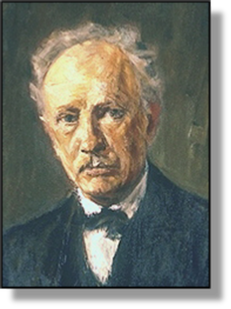 xxxxxThe German composer and conductor Richard Strauss is
primarily remembered today on two counts: His mastery of the
symphonic poem -
xxxxxThe German composer and conductor Richard Strauss is
primarily remembered today on two counts: His mastery of the
symphonic poem -
xxxxxStrauss was born in Munich, the son of a celebrated horn player. He attended the local gymnasium for his general education, but he had inherited his father’s musical skills. He was playing the piano and violin by the age of five, composing by the age of six, and studying theory by the age of eleven. As a young man he played in a local amateur orchestra, and it was then that he first tried his hand at conducting. By then he had written a large number of pieces, including the Festival March, a serenade for wind instruments, a symphony and a violin concerto. Like all his early works, these leaned heavily upon the classical and romantic masters. In 1882 he attended Munich University, but he never worked for a degree and left the following year. By 1884 he was in Berlin, studying part time and playing the piano at various musical functions.
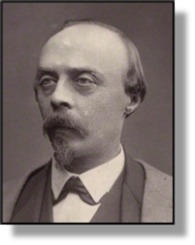 xxxxxIt was while in Berlin that Strauss met the renowned
conductor Hans von Bulow (illustrated) -
xxxxxIt was while in Berlin that Strauss met the renowned
conductor Hans von Bulow (illustrated) -

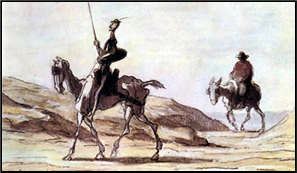 xxxxxIn 1889 Strauss became the director of the Weimar Court
Orchestra. He continued to compose traditional works, but it was in
that year that his symphonic poem Don Juan,
premiered in the November, gave final notice that a new force in
music had arrived. Charged with a score that demanded an orchestra
of unprecedented size, its powerful, expressive music, and its
variety of passages -
xxxxxIn 1889 Strauss became the director of the Weimar Court
Orchestra. He continued to compose traditional works, but it was in
that year that his symphonic poem Don Juan,
premiered in the November, gave final notice that a new force in
music had arrived. Charged with a score that demanded an orchestra
of unprecedented size, its powerful, expressive music, and its
variety of passages -
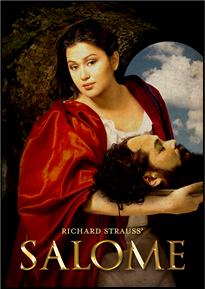 xxxxxThese works, characterised by audacious, colourful
orchestration and seen by Strauss as “the musical expression and
development of my emotions”, shocked audiences by their disturbing
non-
xxxxxThese works, characterised by audacious, colourful
orchestration and seen by Strauss as “the musical expression and
development of my emotions”, shocked audiences by their disturbing
non-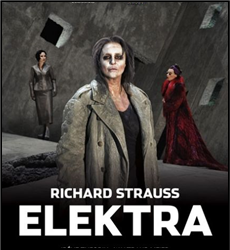 the
erotic Dance of the Seven Veils, and
ending with the scene in which Salome declares her love to the
severed head of John the Baptist, it was roundly condemned for its
blasphemous treatment of a Biblical subject. Newspapers had a field
day, and one described the opera as “moral stench”. (On the other
hand the Austrian composer and conductor Gustav Mahler regarded it
as a “live volcano” and a work of
genius!). Then four years later, Sophocles’ Elektra,
a gloomy drama of bloodthirsty revenge, stunned its audiences by its
near atonal music, its attempt to create a new kind of melody, and
its bewildering use of leitmotivs. New ideas, Strauss responded,
must “search for new forms”.
the
erotic Dance of the Seven Veils, and
ending with the scene in which Salome declares her love to the
severed head of John the Baptist, it was roundly condemned for its
blasphemous treatment of a Biblical subject. Newspapers had a field
day, and one described the opera as “moral stench”. (On the other
hand the Austrian composer and conductor Gustav Mahler regarded it
as a “live volcano” and a work of
genius!). Then four years later, Sophocles’ Elektra,
a gloomy drama of bloodthirsty revenge, stunned its audiences by its
near atonal music, its attempt to create a new kind of melody, and
its bewildering use of leitmotivs. New ideas, Strauss responded,
must “search for new forms”.
 xxxxxAfterxSalome, Strauss went into partnership with the Austrian
poet and librettist Hugo von
Hofmannsthal (1874-
xxxxxAfterxSalome, Strauss went into partnership with the Austrian
poet and librettist Hugo von
Hofmannsthal (1874-
xxxxxStrauss
is particularly well known for his symphonic poems and his operas,
16 in total, but he also wrote a variety of other works, including
two horn concertos -
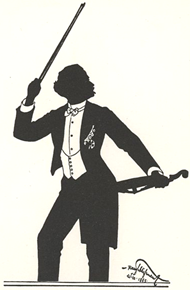
xxxxxAlong
side Strauss’ brilliance as a composer went his skill as a
conductor, influenced in the main by his mentor Bulow. For most of
his life he conducted important orchestras throughout Germany and
Austria, and in 1891, at the invitation of Cosima Wagner, he
conducted the first performance of Tannhauser
to be given at the Bayreuth Festival. He was conductor of the Berlin
Philharmonic Orchestra from 1894 to 1898, conductor and musical
director of the Berlin Royal Opera from 1898 to 1919, and co-
xxxxxDuring the Nazi regime Strauss was appointed music minister in 1933, but was dismissed two years later for working with a Jewish librettist. The opera in question, The Silent Woman, was banned by the government. After the war he was cleared of any collaboration with the Nazi party, and spent the rest of his life at his country home at Garmisch in Bavaira. He died there in September 1949.
xxxxxStrauss
was the last great composer of the romantic tradition, and a worthy
successor to Wagner in the field of German opera. Despite his period
of modernism, he perfected a form -
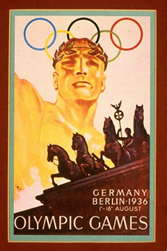 xxxxxIncidentally, Strauss, a
quiet, modest man by nature, married the opera soprano Pauline de
Ahna in 1894. She was a forceful woman, but she encouraged his work,
and the marriage appeared to be a happy one. They had one son,
Franz, and his marriage to a Jewish woman in 1924 made matters
difficult for the family during the Nazi regime. ……
xxxxxIncidentally, Strauss, a
quiet, modest man by nature, married the opera soprano Pauline de
Ahna in 1894. She was a forceful woman, but she encouraged his work,
and the marriage appeared to be a happy one. They had one son,
Franz, and his marriage to a Jewish woman in 1924 made matters
difficult for the family during the Nazi regime. ……
xxxxx…… Strauss composed the Olympic Hymn for the opening of the Olympic Games in Berlin in 1936. The theme was taken from a symphony he planned but never finished. While writing it he confessed to a friend that he had no time for sport of any kind!
Vc-
Including:
Gustav Mahler
and Paul Dukas

xxxxxThe Austrian
composer and conductor Gustav Mahler (1860-
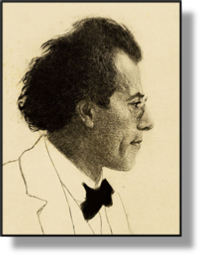 xxxxxA contemporary of Richard Strauss who was also a
competent composer and conductor was the Austrian Gustav
Mahler (1860-
xxxxxA contemporary of Richard Strauss who was also a
competent composer and conductor was the Austrian Gustav
Mahler (1860-
xxxxxMahler was born at Kaliste in Bohemia (now in the Czech Republic), the son of a Jewish shopkeeper. A few months later the family moved to the nearby town of Jihlava, and it was there that Mahler grew up. His early years were not particularly happy ones. As a Jew he was conscious of being an outsider, and his home life was marred by strained relations between his parents. These racial and family tensions might well account for his somewhat troubled personality, and his difficulty in relating to other people. Nonetheless, he showed early talent as a pianist and, influenced by local band and folk music, was trying his hand at composition by the age of six. He made his debut as a pianist when he was ten, and was accepted as a pupil at the Vienna Conservatory just five years later. On completing his musical studies, he attended lectures at the city’s university, and it was there that he was taught and influenced by the Austrian composer Anton Bruckner. After leaving the university he earned his living as a teacher, but was anxious to make his way as a composer. However, his first significant attempt, his cantata The Song of Sorrow, completed in 1880, failed to win the Conservatory’s Beethoven Prize and, on the advice of his piano teacher, he took up a career as a conductor, confining his composition to his leisure time.
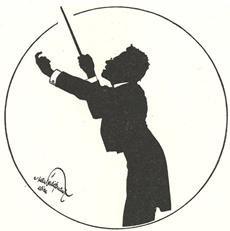 xxxxxOver the next 17 years, by dint of constant hard work
and a ruthless determination to succeed, he battled his way to the
top of his chosen profession. He began his career as assistant
conductor in a summer theatre at the Austrian spa town of Bad Hall,
but then gradually gained experience by way of theatres and opera
houses across Europe. During the 1880s these included theatres at
Ljubljana, Olmutz and Kassel and opera houses in Prague, Leipzig and
Budapest. In 1901 he gained his first permanent position as chief
conductor with the Hamburg Opera House, and three years later,
following the death of Hans von Bulow, was appointed conductor of
the Hamburg Symphony Orchestra.
xxxxxOver the next 17 years, by dint of constant hard work
and a ruthless determination to succeed, he battled his way to the
top of his chosen profession. He began his career as assistant
conductor in a summer theatre at the Austrian spa town of Bad Hall,
but then gradually gained experience by way of theatres and opera
houses across Europe. During the 1880s these included theatres at
Ljubljana, Olmutz and Kassel and opera houses in Prague, Leipzig and
Budapest. In 1901 he gained his first permanent position as chief
conductor with the Hamburg Opera House, and three years later,
following the death of Hans von Bulow, was appointed conductor of
the Hamburg Symphony Orchestra.
xxxxxIt
was while in Hamburg that he was seen by Richard Strauss and Bulow,
both of whom were impressed by his skill as a conductor, and the way
in which he had enhanced the reputation of the 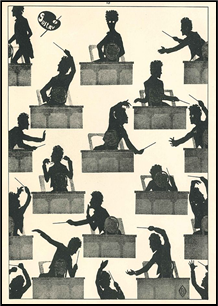 Hamburg
Opera. In 1892 he took the company to London to give the first
performances of Wagner’s Ring Cycle, and
in December 1895 he premiered his own Resurrection
Symphony in Berlin. It must be said that in many of these
appointments his uncompromising stance on achieving the highest of
standards, and the despotic regime he imposed to this end, did not
win him many friends. A number of orchestras were pleased to see him
move on! Personality apart, during this time he did succeed in
promoting the operas of Mozart, Weber and Wagner.
Hamburg
Opera. In 1892 he took the company to London to give the first
performances of Wagner’s Ring Cycle, and
in December 1895 he premiered his own Resurrection
Symphony in Berlin. It must be said that in many of these
appointments his uncompromising stance on achieving the highest of
standards, and the despotic regime he imposed to this end, did not
win him many friends. A number of orchestras were pleased to see him
move on! Personality apart, during this time he did succeed in
promoting the operas of Mozart, Weber and Wagner.
xxxxxMahler was appointed director of the Vienna Court Opera in 1897 at the age of 37. Over the next ten years, by his ruthless quest for perfection, he made Vienna supreme among the opera houses of the world. These were Vienna’s golden years. He cleared the company of its debts and provided performances which set the standards by which others could be judged. In so doing he alienated many by his long, gruelling periods of preparation and rehearsal, but no one could question his immense dedication and determination. And the tours he made across Europe during his time as director added to his fame as a conductor of outstanding merit.
xxxxxExhausted
and weakened by overwork and the beginnings of a serious heart
condition -
xxxxxAs
far as composing w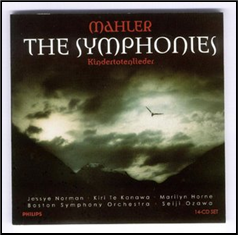 as
concerned, Mahler regarded himself as a part-
as
concerned, Mahler regarded himself as a part-
xxxxxHis
first three symphonies were programme works and incorporated themes
from the German folk anthology entitled The
Youth’s Magic Horn. They sought to find a reason for human
existence in a world which was dominated by pain, despair and the
uncertainties of death. The First,
composed in 1888, lent heavily upon his song cycle Songs
of a Wayfarer, and is noted especially for its macabre
funeral march. The Second, his Resurrection,
complete with soloists and chorus, and based on
Beethoven’s Ninth
Symphony, opened with a funeral ceremony but ended
optimistically with its spectacular choral finale, a joyous
confirmation of the Christian belief in immortality. The Third,
completed in 1896, a vast work of six movements, again with soloist
and chorus -
xxxxxHis
next three symphonies were composed while he was in Vienna. The Fourth, the portrayal of a child’s vision of
heaven, was based upon a song he had written in 1892 entitled The Heavenly Life.
This provided themes for the first three movements and is sung in
full in the fourth. The Fifth Symphony is
remembered especially for its opening trumpet fanfare -
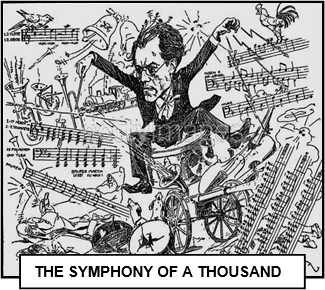 xxxxxHis Seventh Symphony -
xxxxxHis Seventh Symphony -
xxxxxBy
the time Mahler returned home from New York he was fatally ill and
had only a few weeks to live. He died in Vienna in May 1911, and was
buried at Grinzing cemetery in the city. Mahler was first and
foremost an inspired conductor who, by his constant search for
perfection, raised the standard of interpretation and performance to
new heights. As a “part-
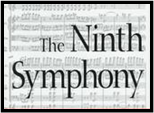 xxxxxIncidentally, bearing in mind
the “curse of the ninth” -
xxxxxIncidentally, bearing in mind
the “curse of the ninth” -
xxxxx…… The three hammer blows which bring to an end his Tragic Symphony No.6, premiered at Essen in
May 1906, were later seen as portending the three tragedies that
beset Mahler in 1907. In that year his three-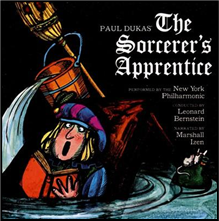 etained
in some performances.
etained
in some performances.
xxxxxIt
was in this year, 1897, that the French
composer and teacher Paul Dukas (1865-
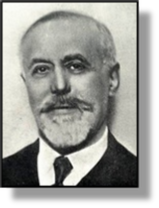 xxxxxDukas was born in Paris, and studied harmony, piano,
conducting and orchestration at the city’s Conservatoire. It was
there that he met the young French composer Claude Debussy, and they
became close friends. Following his military service, he worked as a
successful critic, and in 1910 returned to the Conservatoire to
teach composition. Among his other works were his concert overture King Lear, composed in 1883, his Symphony
in C major of 1896, his oriental ballet The
Genie, produced in 1912, and his Sonnet
de Ronsard for voice and piano, written in 1924. His
skilful orchestration has been described as an intoxicating mixture
of Debussy and Richard Strauss.
xxxxxDukas was born in Paris, and studied harmony, piano,
conducting and orchestration at the city’s Conservatoire. It was
there that he met the young French composer Claude Debussy, and they
became close friends. Following his military service, he worked as a
successful critic, and in 1910 returned to the Conservatoire to
teach composition. Among his other works were his concert overture King Lear, composed in 1883, his Symphony
in C major of 1896, his oriental ballet The
Genie, produced in 1912, and his Sonnet
de Ronsard for voice and piano, written in 1924. His
skilful orchestration has been described as an intoxicating mixture
of Debussy and Richard Strauss.
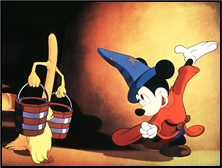
xxxxxDukas’
dazzling scherzo The Sorcerer’s Apprentice
became internationally famous in 1940 when the American film
producer Walt Disney featured it in his symphonic concert entitled Fantasia. The part of the apprentice was taken
by his cartoon character Mickey Mouse, and the Sorcerer was named
Yen Sid -


